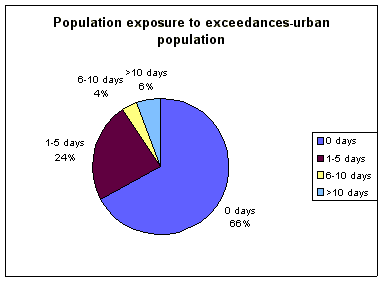4. EXPOSURE TO EXCEEDANCES
4.1 Population exposure
The actual outdoor exposure of the population to ozone is difficult to
estimate. In addition to estimating the spatial distribution and time variation of the
ozone concentration, the location and physical activity level of the population should be
known. Since detailed data about these variables is not available, the description of
exposure must be limited to estimating the number of people who possibly experienced
('were potentially exposed to') at least one exceedance of ozone concentrations above the
information threshold value during summer 1997.
For urban areas, using a Geographical Information System, the location
of urban stations was combined with information on the European population provided by
Eurostat (EUROSTAT, 1996). This database lists ca. 2100 cities in the EU with more than 25
000 inhabitants. It is calculated that from a total EU population of ca. 362 million, ca.
195 million people live in these cities. Approximately 75 million people live in cities in
which at least one ozone station was operational during the 1997 summer season (38% of the
total EU urban population or 21% of the total EU population).
157 cities reported at least one exceedance of the population
information threshold value. Approximately 25 million people in these cities1
(34% of the urban population living in cities with operational monitors) were potentially
exposed to at least one exceedance. The urban exposure estimates are presented in Figure
9.
The results should be interpreted with great care. In many cities, only
one station is operational and exceedances at such a station were attributed to the whole
urban population. The current description of station types is imprecise and for a
substantial number completely missing. Nevertheless, it is obvious that urban population
exposure estimates cannot be based on monitoring results alone, since monitoring stations
cover only 38% of the total urban population.
The number of people "potentially exposed" as calculated for
this report cannot be compared with the calculated number published in last year's report
(Sluyter and van Zantvoort, 1996). This year calculations were made for the period
April-August (1996: April-July). Moreover, the population database used was updated and
the number of stations (coverage) has increased.

Figure 9: Number of exceedances (in days) and frequency distribution
of urban population potentially exposed to hourly ozone concentrations exceeding 180 µg/m3,
April-August 1997. (Representative for an urban population of 75 million (38% of the EU
urban population) living in cities with more than 25 000 inhabitants; 21% of the total EU
population).
For rural areas, the number of people potentially exposed to at least
one exceedance could not be calculated. The interpolated exceedance 'field' (Map 3) is
rather fragmented. Moreover, no rural population database is available at the moment.
However, as ozone levels are in general higher in rural areas than in cities, it is
anticipated that a larger fraction of the rural population will be potentially exposed to
exceedances than in cities.
4.2 Territorial exposure
The interpolated exceedance map for rural locations with an assumed
radius of representativeness is too fragmented to draw firm conclusions on spatial
patterns. The rural stations cover approximately 48% of the EU territory. The area where
exceedances were observed, calculated on the basis of the interpolated map, is
approximately 49% of the total area covered by background stations which is estimated at
23% of the total EU territory. These figures are comparable to those observed during
summer 1996.
1 This figure cannot be compared directly with figures
provided in earlier reports covering summer 1994 and summer 1995 as the basis for
calculation was not the same.


Document Actions
Share with others